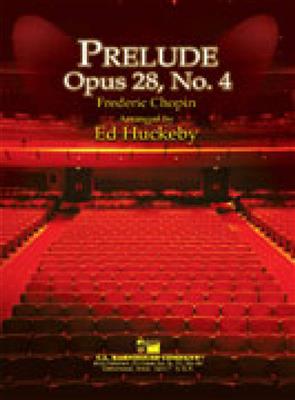Results
-
 £89.99
£89.99And The Angels Called - James Swearingen
Reflective, joyous and uplifting are but a few of the words that best describe this highly dramatic work by noted composer James Swearingen. Intended as a tribute, this composition musically celebrates three wonderful high school students whose lives were all tragically taken. Great compositional writing, memorable themes and an emotional middle section based on an old English hymn, all combine to create an outstanding piece that is well-suited for contest and festival use. Your students will greatly benefit from the various solo opportunities and the powerful ending will leave your audience with a tremendous feeling of hope and resolve. Incredibly stunning!
Estimated dispatch 7-14 working days
-
 £71.50
£71.50Prelude, Opus 28, No. 4 - Frédéric Chopin
One of Frederic Chopin's best known works, Prelude, Op. 28, No. 4, presents emotion-packed performance opportunities for bands at all levels. This Ed Huckeby transcription for band provides an almost literal translation of Chopin's original work with tremendous musical challenges in both the interpretive and dynamic realms, providing the ensemble an opportunity to explore musical possibilities which might be less attainable in a more technical piece. The recognizable melodic and harmonic structures will make this piece a real "hit" with concert audiences and provides an opportunity to teach the musical styles of the greatest 19th century composer of piano music. Great music!
Estimated dispatch 7-14 working days
-
 £74.99
£74.99To The Stars! - Poor
Driving percussion motifs, dramatic brass and woodwind flourishes combine for an exciting opening to this bold fanfare for younger bands. Featuring the winds, a contrasting canon provides an intriguing middle section. The persistent drive of the opening returns for a bold coda that brings the work to an exhilarating close. Perfect for opening any concert program.
Estimated dispatch 7-14 working days
-
 £85.50
£85.50The Great Land Run - Anderson
An exciting journey through the old west, "The Great Land Run" paints an exhilarating picture of 1889 Oklahoma. A fanfare-like main theme at the beginning is followed by the night around the campfire. As the settlers rest, a gentle storm washes over them bringing forth the questions of what tomorrow may bring. As morning rises, they head back on their way to stake their plot of land and new life. A powerful recap of the main theme drives this piece to an exciting end. With multiple opportunities for solos in the flute, clarinet, oboe, and trumpet, this piece will offer a fun, yet challenging experience for any concert band! Highly recommended!
Estimated dispatch 7-14 working days
-
 £85.50
£85.50Force of Destiny - Larry Neeck
Commissioned in honor of a beloved band director who passed away at too young an age, Force of Destiny is a bold, beautiful, and upbeat celebration of the meaning of life and the pursuit of one's destiny. A gentle introduction leads to up-tempo themes that are alternately martial and lyrical. The delicate middle section, which builds to a powerful climax, provides an expressive showcase for your band. A strong restatement of the opening theme powers to a bold and dramatic finish. The variety of themes, tempos, colors, and expressions in this piece make it ideal for contest or competition, and an excellent way to showcase the subtly and power of your ensemble.
Estimated dispatch 7-14 working days
-
£142.50
Fatinitza - Franz von Suppé
The delightful and charming overture to the comic opera "Fatinitza" is finally available in a wonderful transcription by Andrew Glover. An excellent selection for mature bands seeking an enjoyable work that's also an audience-pleaser. Set includes a large spiral-bound conductor score.
Estimated dispatch 7-14 working days
-
£86.50
Trek! - Herb Bassett
"Trek!" depicts three phases of a thrilling mountain bike ride: acceleration through the gears, tranquility of the ride, and an uphill climb and descent. While the eighth note remains constant throughout, changing meters, rising ostinati, and widening Doppler-shifts all imply acceleration leading to a break-neck downhill ride for a dynamic ending. Modal harmonies and an optimistic tone make "Trek!" fun to perform and exciting to hear! An energetic program selection or closer for concert or festival. Electrifying!
Estimated dispatch 7-14 working days
-
£80.99
To Honor America - James Swearingen
"To Honor America" presents an invaluable collection of patriotic songs, sure to become a staple for bands to perform whenever there's an occasion to highlight the accomplishments of our courageous military soldiers, both past and present. Deeply moving, and an all-around "feel good" piece are qualities that best describe the overwhelming sense of pride that you'll gain from hearing this music performed. It is simply spectacular in every sense of the word.
Estimated dispatch 7-14 working days
-
 £52.99
£52.99Pachyderm Peanut Posse - Orcino
A delightful tune for very young players at an "Ellaphante" tempo. Very easy since horn parts consist only of quarter, half and whole notes. Percussion includes parts for snare and bass drums plus an easy part for tom-toms and a slightly more difficult wood block part. A great way to present your youngest students in a very positive light and sure to be an audience favorite!
Estimated dispatch 7-14 working days
-
 £48.50
£48.50Surge - Robert W. Smith
The boundless energy of young musicians is captured and focused in "Surge," an exciting work for the beginning band. A bold ostinato in the low brass and woodwinds provides momentum as interacting rhythmic figures and flowing counter lines create an intense musical experience. As you have come to expect from master educator/composer Robert W. Smith, "Surge" is an excellent teaching tool that will appeal to both performer and audience!
Estimated dispatch 7-14 working days
